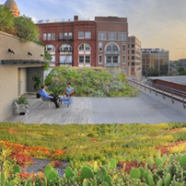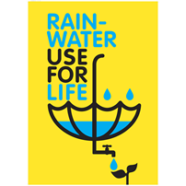the Landscape Architect’s Irrigation Consultant
True to our tag line Often times we refer to ourselves as “the Landscape Architect’s Irrigation Consultant” and one of our recent projects certainly lives up to that tag line. We were pleased to work with the world renowned firms of Oehme van Sweden Landscape Architects and Gensler Architects to complete a project for the ASLA Headquarters in Washington D.C. area as part of their ongoing energy star initiatives. As the consultant to Landscape Architects we designed the irrigation to compliment the designs for their new rooftop garden and corresponding courtyard. Irrigation Design Components Key components to the design involved the incorporation of a complete water harvesting system to collect stormwater from the roofs for complete recycling of the water into the irrigation and weather monitoring to provide optimum water use for the landscape materials. The water harvesting system has multiple flow meters and sensors to monitor not only the stormwater collection volume but also collect data to show the amount of water demanded by the irrigation and any additional make-up water needed. To maximize the water consumption and only use what is needed for the plant material the design incorporates an onsite weather station to measure temperature, humidity, solar radiation, wind and rainfall to calculate the daily ET (evapotranspiration rate). Additionally soil moisture sensors are installed to track soil conditions in key areas within the landscape. The majority of the rooftop irrigation and courtyard utilizes drip irrigation to also reduce overspray, evaporation and deliver water to the roots of the plants. All of the irrigation is then controlled with the Toro Sentinel Control System that provides complete monitoring and control incorporating weather driven updating, moisture sensors and monitoring for all flow conditions. Sentinel Water Management Software (WMS) is a Microsoft® Windows-based program that allows users to control daily irrigation operations and scheduling from a powerful yet easy-to-use platform. With the ability to control up to 999 field satellites from one location, users have a water management tool that provides ultimate customizability and reliability. ASLA Efforts to Green Communities The headquarters of the American Society of Landscape Architects helped Washington, D.C., rank second on the U.S. Environmental Protection Agency’s (EPA) 2014 list of the top U.S. cities with the most ENERGY STAR certified buildings. ASLA has participated in EPA’s ENERGY STAR certification since 2008, and its headquarters building was ENERGY STAR-certified again in 2013. Among buildings the same size, ASLA’s energy performance is in the top 11 percent. ASLA’s headquarters employs energy-efficient systems and practices-including a green roof that reduces energy usage by 10 percent in winter months. Sustainability is part of the organization’s leadership and staff culture. Your Irrigation Consultant If you are looking to design a water efficient irrigation system or looking to update an existing area to incorporate new technology we invite you to contact us at Landtech Design. No project is too small or large for our team to tackle. Working with your ideas and designs we can develop a plan to fit your budget and concept requirements. Name(required) Email(required) Company Comment(required)...
Read MoreRainwater Harvesting for 2017
Old practices now new ideas… Rainwater harvesting dates back to early civilizations, however in 2017 we see the cost of water driving the interest in collection of rain water to the forefront in building designs. From large commercial buildings to residential design, the incorporation of collecting water has seen a wide variety of systems developed, and varied applications on successfully recycling water into our environment. You can incorporate a simple rainwater collecting tank off your home roof collection downspout, or to large scale underground holding tanks and pumps for large commercial applications. Harvesting Components Understand the basic components to every rainwater harvesting system: Filtration – to collect the water you must first plan to filter and remove debris as the rainwater is coming off the roof or collecting surface Sanitation – for large scale and public collection sites you will need to consider sanitation to kill algae, parasites or other pests that may enter the storage unit Chlorination – for simple residential systems the addition of chlorine may solve most algae or similar issues Water Storage System – from barrels, large steel tanks, underground storage…correctly sizing the storage for the site collection is key to success Applying or using Harvested Water – Simple gravity feed or pumping systems with full monitoring and controls is available depending upon size of system For ease and simplicity for most residential installations we recommend working with complete kits available through Kenney Outdoor Solutions and Atlantic Water Gardens. These kits, complete with submersible on-demand pumps provide everything you need to store and distribute up to 1000 gallons of harvested water. Rainwater Harvesting Benefits As water conservation continues to be a key role in reducing our total consumption of our valuable resource of water consider the following benefits of Rainwater Harvesting is meeting your water conservation goals: 1.Easy to maintain- the overall cost of installation and ongoing maintenance is minimal and easy to maintain making it an easy option to incorporate with most residential or commercial irrigation designs. 2.Reducing water utility bills – water collected by the systems can be used for several non-drinking functions and thereby reducing the use of city water and lowering monthly water bills. Rainwater is free from many chemicals and makes it suitable for irrigation and watering gardens. 3.Reduces demand on groundwater-with increased population and higher demand for water, in many areas there are concerns on depletion of precious ground water supplies. To learn how a rainwater harvesting system might be incorporated into your next irrigation design Name(required) Email(required) Company Name(required) Comment(required) Submit...
Read More




